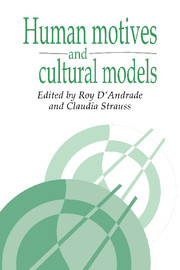Book contents
- Frontmatter
- Contents
- List of illustrations
- Preface
- List of contributors
- 1 Models and motives
- Part I Cultural models as motives
- Part II How do cultural models become motives?
- 4 How cultural systems become desire: a case study of American romance
- 5 The motivational force of self-understanding: evidence from wives' inner conflicts
- 6 The directive force of morality tales in a Mexican community
- 7 Learning to be an American parent: how cultural models gain directive force
- Part III Cultural models as motives reconsidered
- Index
6 - The directive force of morality tales in a Mexican community
Published online by Cambridge University Press: 05 June 2012
- Frontmatter
- Contents
- List of illustrations
- Preface
- List of contributors
- 1 Models and motives
- Part I Cultural models as motives
- Part II How do cultural models become motives?
- 4 How cultural systems become desire: a case study of American romance
- 5 The motivational force of self-understanding: evidence from wives' inner conflicts
- 6 The directive force of morality tales in a Mexican community
- 7 Learning to be an American parent: how cultural models gain directive force
- Part III Cultural models as motives reconsidered
- Index
Summary
This chapter addresses the issue of how meanings come to direct behavior by analyzing the ways in which the cultural representations contained in folklore operate both to teach schemas and to motivate listeners to act in accordance with the goals they generate. Research on this topic was conducted in a rural, agricultural community of 2,000 people located in the state of Oaxaca in Mexico. The inhabitants, of mixed Zapotec and Mixtec descent, now label themselves ethnically as Mestizos. The community economy is based primarily on subsistence farming. Residents live in patrilocal, extended households and continue to regulate their own internal affairs through participation in a hierarchy of civil and religious offices known as the cargo system (see Mathews 1985). Traditionally, folklore has been an integral component of everyday activity as well as of ritual practice. Many types of lore abound in the community, but one genre in particular, that of the morality tale, stands apart as a form that has compelling directive or motivational force.
Morality tales are concerned with evaluating and shaping courses of action. The texts of such tales contain a great deal of information about cultural expectations for behavior as well as about the bases of individual motivation for such behavior. I chose to explore these bases for motivation by analyzing sixty informant accounts of the morality tale of La Llorona or the “Weeping Woman.” This tale is particularly appropriate for a study of motivation for two reasons.
- Type
- Chapter
- Information
- Human Motives and Cultural Models , pp. 127 - 162Publisher: Cambridge University PressPrint publication year: 1992
- 22
- Cited by



